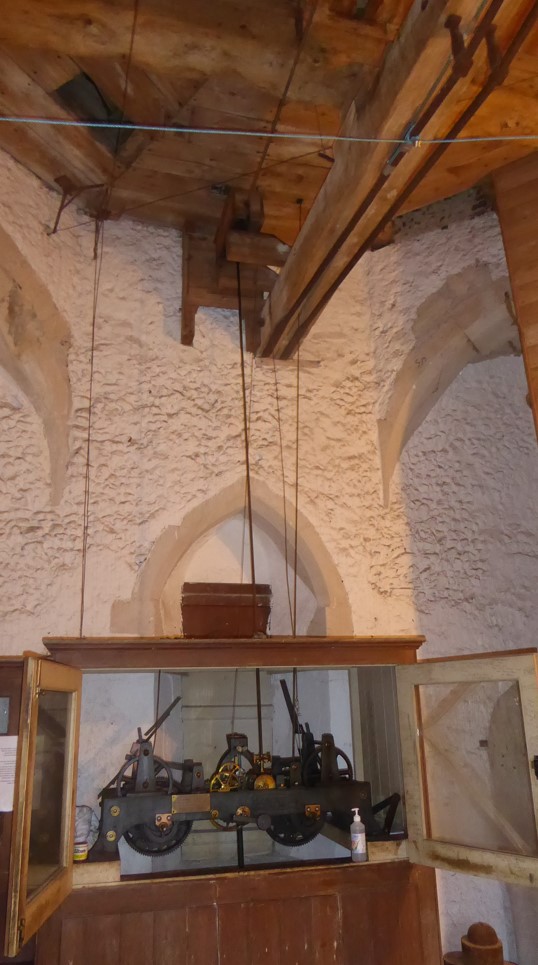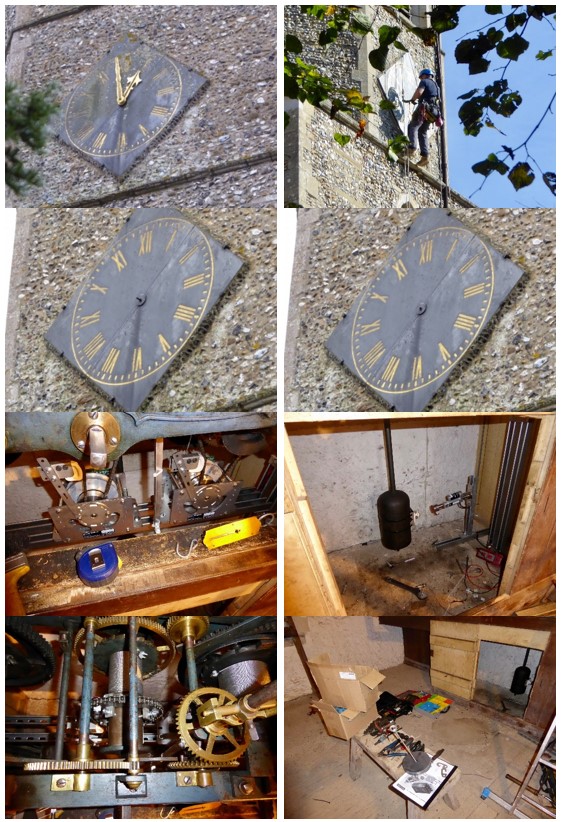St Mary's Church, Cheveley
The Tower, Bells and Clock 2022
The Tower
In the first half of the 14th century, the height of the tower was raised with an octagonal stage housing the bells. It appears there was an open balcony at the top, the outline of which can be seen in the masonry on the north side and now an enclosed chamber within the belfry.
The Bells
There are five bells suspended on a medieval bell frame. The oldest bell is inscribed “Sancta Anna Ora Pro Nobis” (St Ann pray for us). This is the Sanctus bell (the bell traditionally rung immediately before the consecration of the bread and wine at the communion service).
Two are inscribed “Thomas Gardiner, Sudbury, fecit (made it) 1730”.
The fourth is inscribed “Rev. James Thomas Hand (vicar 1778-1831) Joseph Collins, Thomas Martin, Churchwardens. Thomas Osborne, founder, Downham Market, 1800”.
The fifth is inscribed “Thomas Revel, Thomas Peck, Churchwardens. John Thornton, Sudbury, fecit, 1718.
The bells are not swung now because of damage caused to the tower by the bell frame, but are rung by chiming, the clappers being attached to cables which are operated by one person in the clock chamber.
If you stand under the tower facing the nave and look up at the arch you can see grooves in the stone, probably caused by the bell ropes.
The Clock
The clock, which is a turret clock, was made by Messrs. Smith of Derby (who are still making and repairing clocks). It was presented by Col. Henry McCalmont in 1897 to commemorate Queen Victoria’s Diamond Jubilee.
Up until November 2021 the clock was wound and regulated by hand twice a week by a small group of volunteers.
After kind donations and grants the clock was fully restored by the same firm who manufactured the clock in 1897. The clock is now fully automated and the time regulated by a radio link.
The other clock housed in the clock chamber was made by George Clarke of Leadenhall Street, London.
It is not known how old this instrument is (George Clarke is recorded as working in Leadenhall Street from 1725 with his death recorded in 1776). There is reference to it in 1847, when it was agreed to sell the old clock bell, and again when it was restored in 1864. In 1886 it was decided to stop the clock because “it is very old and keeps bad time”.
The following year it was given a reprieve as there was no money to purchase a new one!

The Future of the Tower Clock
Have you ever stopped near the church to check the time of day? Do you hear it strike the hour? Would you miss it if it stopped?
Interesting facts:
The clock is more than 120 years old. The current mechanism was installed to celebrate Queen Victoria’s Diamond Jubilee.
The clock strikes the bell 156 times a day or 1064 times a week. Over its lifetime this is nearly 7 million strikes.
Each strike releases 39.545mm of cable. In those 120 years the weight has descended (and been wound back again) more than 160 miles.
120 years is nearly 4 billion seconds, the pendulum swings once a second.
It needs to be wound every two or three days. That means a round trip of 86 steps each occasion which equates to over 10500 steps per year.
General information:
The clock is by “Smith and Sons” of Derby, installed in 1897-1898. The much older clock (circa 1750) it replaced is housed in a case alongside.
The hour is struck on the Tenor bell, one of a ring of five bells that no longer ‘swing’. They are all rung by ropes attached to the clappers via pulleys in the clock chamber.
The clock has not been serviced professionally for several years and many parts are in need of repair or replacement. As our team of volunteers are getting smaller in number, and in order to keep the clock working for the next century, we think the way forward would be to have the clock repaired, the clockfaces cleaned and re-gilded and the mechanism fully automated.
Would you help us raise the £18000 needed?
If so, please contact Celia on 01638 731601
or stmaryscheveleytreasurer@btinternet.com

Update - April 2021
As you may know the church clock is in need of repair and restoration. Installed in 1879 it has let the village know of the time almost every day since. However, her age is catching up on her and there are now many parts that need attention. One local resident recently said “The hourly chime of the clock makes everything normal”.
The PCC has decided that the time is right to automate the clock mechanism. This will save our small band of aging volunteers who wind the clock, the regular climb of the tower steps.
Thanks to a grant of £1500 from .
ALLCHURCHES TRUST LIMITED
we are a few steps closer to the £8000 required to start this phase of the work. Donations to the appeal are also much appreciated.
Allchurches Trust is one of the UK's largest grant-making charities and gave more than £23 million to churches, charities and communities in 2020. Its funds come from its ownership of Ecclesiastical Insurance Group.
Update - May 2021
Permission has now been granted as below...
Church of Cheveley: St Mary
NOTICE IS GIVEN that we are applying to the Consistory Court of the diocese for permission to carry out the following:
Refurbishment of turret clock movement and fitting of auto-winding machinery, external cleaning of clock dials.
Copies of the relevant plans and documents may be examined at.....
Time for an Update (July 2021)
Cheveley church clock, installed in the tower in 1878-1879, is in need of some TLC and I have been trying to raise £18,000 to get it restored and automated.
As at 17th July 2021, I have reached £14,434.39. Thanks to four very generous grants and many smaller donations, the balance has grown slowly.
Many of you may remember that due to Neil’s enforced retirement, Cheveley Church Council brought forward plans to renovate the clock mechanism and, if funds allowed, clean and re-guild the two clock faces. The two elements of the work was estimated at £17,000 + vat.
In November 2020, the decision was made to endeavour to raise enough to automate the mechanism, thus saving our merry band of four senior volunteers the onerous task climbing 40 of the 92 steps of the tower, two or three times a week to wind the clock.
So what will we do now you may ask.
The clock restorers have been given the job of stripping down and rebuilding the clock mechanism and installing an automatic winder. I will carry on fundraising for the shortfall of £2,200 - no easy task when Covid-19 has shut down the vast majority of possible funders.
The clock is an integral part of village life and as one resident said to me, “the chime of the clock gives normality to these strange times” If every household in the village made a small donation the target would easily be met. Would you be willing to forfeit a paper or a coffee to get us back on time?
Time for another Update (August 2021)
The very good news is that with your help, I have raised £18038.63. I still have a couple of donations to come, but it is now all systems go……
As a result, the clock restorers are due to start the first phase in the next few weeks followed by the rope team (face cleaners) in late September.
The clock will be silenced for a short while, (due to stop week commencing 20th September) but the final results will be worth it. Thank you to everyone who gave to the appeal, the clock will now continue to tell us the time for many years to come.
Need a hand (or two) (September 2021)
Well the clock has been cleaned, repaired and automated. The clock faces have been re-gilded with 23.5 carat gold and are now awaiting the hands. They, however, are in the workshop for some repairs.
Another couple of weeks to wait, but it should be back to chiming the hour soon.

Sadly No Tick or Tock - yet (Oct 2021)
The engineers had problems getting the hands off the North face, so they have now gone back to the workshop for repair. The spigot holding the hands has also gone. see third clock face picture.
Hoping all will be well by mid-November

Ring Out the Bells - (November 2021 - Restored)
At midday on Friday 12th November the Cheveley St. Marys church turret clock chimed for the first time since it was silenced for restoration and automation which officially began on the 20th September.
Prior to that time the project had to start by getting quotes (sit down – about £18,000), raise the money, contract Smith & Son of Derby (who originally made and installed the clock in 1897), get an inspection, raise public notice form 4A, install an electrical spur, and wrestle a 5.4m ladder up 40 spiral stairs before the start date. All this completed by volunteers.
By lunchtime on the 20th the clock mechanism is on the floor of the clock chamber in a 1000 pieces undergoing a thorough cleaning. The abseilers on ropes from the tower roof could be seen dangling mid air trying to get the hands free from the dials. Sadly after 120-odd years they were reluctant to leave and had to be cut away and sent off to the factory for repair.
On the second day the clock and chime winder mechanisms, which will take over from volunteers manually winding every few days, and the pendulum grabbing solenoid are installed and hooked up to the radio control master clock. Meanwhile the rope men are back in mid air starting to re-guild the dials. By late afternoon the numbers and the dial had received a coat of 23.5 carat gold.
The engineers then departed for the next six weeks leaving the clock to tick away to itself and the bells silent whilst the hands were repaired and re-guided. On 12th November the rope men are back. First the hands are replaced, then set to 12. The clock mechanism is reset and they hold their breath whilst a little black box synchronises itself to the master clock in Rugby.
At 11:30 it is the turn of the volunteers to climb the stairs to view and receive a briefing on the do’s and don’ts. Now all the team have to do is regularly check it keeps ticking over. Please let us know if you ever notice the first chime of the hour being more than 5 seconds out.




